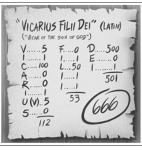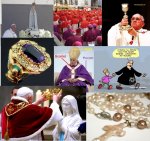VCO, here is my interpretation. Please let me know how reasonable or unreasonable it sounds to you.
-------------------------------------------------------------------------------------------------------------------------------------------------
Daniel's 4th beast represents the Roman Republic with the rise of the
little horn signifying it's transition to the Roman Empire. The
little horn uprooted three horns. The little horn represents the rise of Julius Caesar and the three uprooted horns represents the First Triumvirate (power delegated to three persons). Julius Caesar dismantled the Triumvirate to become dictator.
The Roman Empire officially began in 27BC, but it's understood that Juluis Caesar was pivotal in turning the Roman Republic into an Empire.
The little horn is not Julius Caesar per say, but represents the rise of the Roman Emperors.
The
1st beast in Revelation is a continuation of the description of the
4th beast in Daniel.
The
Roman Emperors were declared as gods after they died and were worshiped. They were responsible for killing early christians and Constantine's Dynasty made christianity legal and can be seen as the
head with a mortal wound that healed.
The
42 months in Rev 13 and
a time, times and half a time in Daniel 7 both represents
1260 years. So this would have to mean that the Roman Empire lasted
1260 yrs.
Julius Caeser's First Triumvirate was 60BC and he became dictator 49BC
So the beginning of the Roman Empire started loosely around
~55BC
Then The capital of the Roman Empire became Constantinople in
330AD. The Roman Empire split in 476AD and continued as the Eastern Roman Empire (aka the Byzantine Empire). Centuries after the rise of the Roman emperors (
rise of the 1st beast) came the rise of the Roman Popes
(rise of the 2nd Beast). The Popes (
2nd beast) were essentially appointed by the emperors (
1st beast) and so the Popes (
2nd beast) were
allowed to work and exercise authority in the presence of the Emperors (
1st Beast).
After 752AD the Byzantine Emperors no longer appointed popes, but there began a divide in the church between Latin (
Roman) and Greek (
Byzantine). Up arose in the Byzantine Empire were the
Ecumenical Patriarchs of Constantinople.
Even though the emperors of Constantinople (
1st beast) no longer appointed the Roman Pope (
2nd beast) after 752 AD they still appointed the Ecumenical Patriarchs of Constantinople (which became
the 2nd horn of the
2nd Beast). As time progressed the split between The Latin (
Roman) and the Greek (
Byzantine) churches became more apparent.
Finally, in
1204 AD the fourth Crusade resulted in the
sacking of Constantinople. This sacking of Constaninople dealt an irrevocable blow to the already weakened Byzantine epmire, and can be considered the end to the Roman Empire. This 1204 event was also a prominent act that solidified
the schism between the
Greek and
Latin churches.
Establishing the Two Horns of the 2nd Beast.
If you go from
~55BC to ~1204AD we have a period of
~1260 yrs representing the beginning and ending of the Roman Empire (
The 1st Beast of Revelation).
------------------------------------------------------------------------------------------------------------------------------------------------
In 1059AD we see there was a decree made concerning papal elections. This decree helped to establish a process for papal appointment and to shield appointments being made from secular rulers. This brought more authority to the Papal throne (2nd Beast).
The
1st Beast (Roman Empire) was allowed to exercise authority for 1260 years. So we see that over time (as the Roman Empire declined) this authority went over to the
2nd Beast (Papal Authority).
HOW SAD, you have topped the CAKE, on ridiculous interpretations.
1
1


